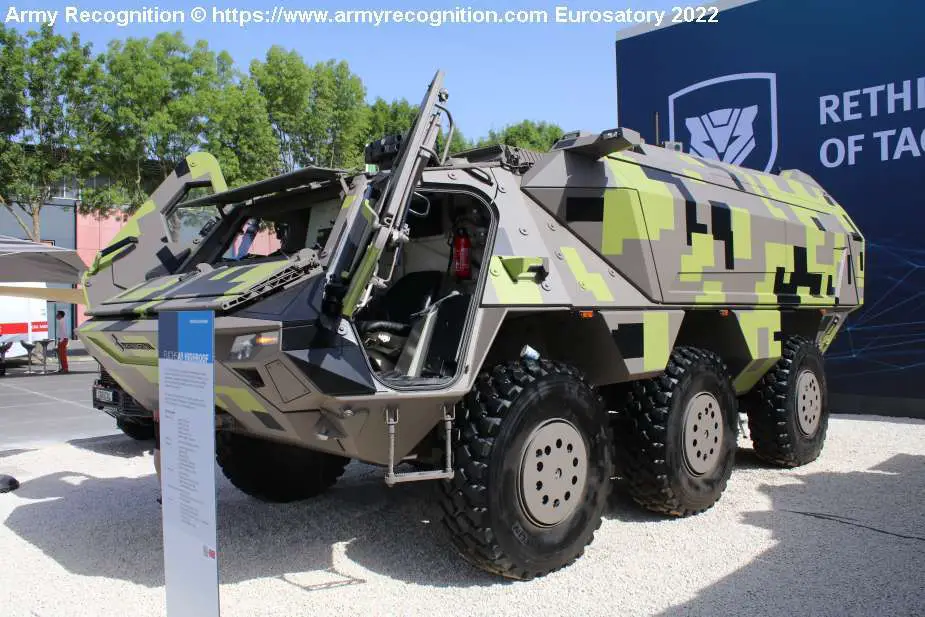Breaking news
Germany to purchase up to 900 Fuchs 6x6 armored personnel carriers.
According to Bloomberg on April 8, 2024, Germany's government is set to initiate military investments of up to €7 billion ($7.6 billion). This plan includes the acquisition of two additional F126 frigates at a cost of about €3 billion, and up to 900 Fuchs 6x6 armored personnel carriers (APCs), with a projected value of up to €4 billion.
Follow Army Recognition on Google News at this link

The latest iteration in the Fuchs line, the Fuchs A9 High Roof, also known as Fuchs Evolution, was introduced by Rheinmetall during the Eurosatory 2022 exhibition. (Picture source: Army Recognition)
For the German Navy, the plan includes a purchase agreement for two navy F126 frigates at a cost of about €3 billion, raising the total fleet to six units. The procurement process involves cooperation with the Dutch company Damen Schelde Naval Shipbuilding BV as the lead contractor, alongside French company Thales and Germany's Blohm und Voss.
The F126 is a frigate powered by a CODLAD (Combined Diesel-Electric And Diesel) propulsion system with an output of 32 MW, allowing it to achieve speeds exceeding 26 knots. Armament includes an array of weaponry such as Otobreda naval guns, anti-ship and air defense missiles, and CIWS launchers. The ship is equipped with advanced sensing, radar, and electronic warfare systems for enhanced situational awareness. It has the capacity to carry two NH90 Sea Tiger helicopters and a UAV, extending its operational capabilities. The incorporation of SurfSAT-L terminals improves satellite communication, providing secure connectivity across multiple bands, essential for command operations and crew welfare. This combination of propulsion, armament, surveillance, and communication technologies equips the F126 frigate for a range of naval warfare and strategic tasks.
Additionally, the government intends to confirm an order for as many as 900 Fuchs 6x6 armored personnel carriers (APCs), with a projected value of up to €4 billion. These vehicles, produced by Rheinmetall Landsysteme GmbH, are expected to be delivered starting in 2025, aiming to enhance the mobility and protection of Germany's ground forces.
Approval from the lower house of Germany's parliament is necessary for the procurement plans to proceed, which follow the country's response to the Ukraine conflict. Chancellor Olaf Scholz announced a special €100 billion fund for military spending, which is in addition to the regular annual defense budget of approximately €52 billion. This funding has allowed Germany to achieve NATO's defense spending target of at least 2% of its gross domestic product annually, a goal set in 2006, for the first time.
The commitment to maintain this level of spending is set to continue even after the special fund runs out in 2027. The reapplication of a constitutional borrowing limit, which was suspended during the Covid-19 pandemic and the energy crisis, is anticipated to introduce financial limitations. However, Germany's Finance Minister Christian Lindner has informed cabinet members that the defense budget will be maintained at its current level for the following year, while other ministries will need to decrease their spending.
As part of this €7 billion modernisation strategy, the German army appears to be focusing on improving its fleet of armored personnel carriers (APCs), and more specifically the Fuchs 6x6. The Fuchs 1 is a German 6x6 armored personnel carrier known for its adaptability since its introduction in 1979. Originally developed by Daimler-Benz and further advanced by Rheinmetall MAN Military Vehicles (RMMV), the Fuchs was among the early wheeled armored vehicles in service with the Bundeswehr, the West German military. It possesses amphibious capabilities and has been utilized in various roles, including troop transport, engineer transport, bomb disposal, and as a platform for Nuclear, Biological, and Chemical (NBC) reconnaissance and electronic warfare. Over time, the Fuchs has undergone upgrades, including the Fuchs 2 and the Fuchs A9.
The Fuchs 2, succeeding the original model, was introduced in the early 2000s, showcasing advancements such as increased payload capabilities, a higher rear crew compartment for added space, and a more powerful engine meeting lower emission standards. This version is capable of carrying heavier loads and features modern digital systems and upgraded drive and brake components to match its increased power and weight specifications. These improvements cater to a broad range of military needs, extending its serviceability and functionality on the battlefield. The vehicle has seen service with various armed forces worldwide and has participated in international operations, including in the Middle East and Kosovo.
The latest iteration in this line, the Fuchs A9 High Roof, also known as Fuchs Evolution, introduced by Rheinmetall during the Eurosatory 2022 exhibition, brings further enhancements, particularly in mobility, protection, and payload capabilities. It features a new powerpack, digital electrical vehicle architecture, and a high roof design providing the largest possible interior volume for various mission kits. Designed to address the aging Fuchs fleet and potentially extend its operational life beyond 2040, the Fuchs A9 offers configurations such as a Command Post and an armored ambulance. The vehicle incorporates an advanced 360-degree panoramic vision system, substantially improving the crew's situational awareness. Additionally, the Fuchs A9 High Roof is equipped with a new armor package to better protect against modern ballistic threats and IEDs.


























